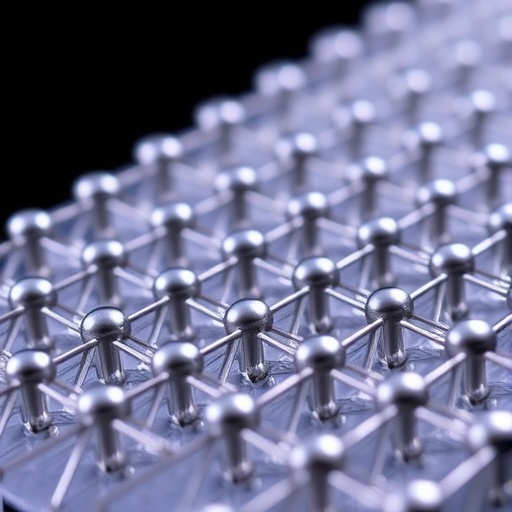In the ever-evolving landscape of energy storage technologies, the quest for more efficient and durable materials has led to groundbreaking innovations. A recent study delves into a novel approach by exploiting bimetallic metal-organic framework (MOF) nanosheets as potential anode materials for lithium-ion batteries. This pioneering research, led by Liu et al., promises to transform the performance capabilities of lithium-ion technology, which is essential for a variety of applications, ranging from consumer electronics to electric vehicles. As lithium-ion batteries continue to dominate the energy storage market, improving their efficiency, lifespan, and sustainability is paramount.
The study presents a compelling argument for the utilization of bimetallic MOF nanosheets. These materials are not just effective in their immediate application; they also exhibit remarkable synthetic versatility. By leveraging the unique structural characteristics of bimetallic MOFs, researchers have synthesized nanosheets that are tailored for high electrical conductivity and increased electrochemical stability. This breakthrough opens pathways for enhanced charge and discharge dynamics, addressing one of the primary limitations of conventional anode materials, which often struggle with rapid cycling and deterioration over time.
In comparing these bimetallic MOF nanosheets with traditional materials, the team conducted extensive experiments that showcased the advantages of their innovative design. Standard materials often face issues related to volume expansion during cycling, leading to mechanical failure and diminished capacity. However, the bimetallic MOF structure provides a flexible framework that can absorb these changes, thereby extending its lifespan and maintaining efficiency over numerous charge cycles. This resilience makes it a formidable candidate for the next generation of anode materials in lithium-ion batteries.
.adsslot_UO9Wh3M7Lw{width:728px !important;height:90px !important;}
@media(max-width:1199px){ .adsslot_UO9Wh3M7Lw{width:468px !important;height:60px !important;}
}
@media(max-width:767px){ .adsslot_UO9Wh3M7Lw{width:320px !important;height:50px !important;}
}
ADVERTISEMENT
Further examination of the nanosheet morphology revealed the influence of size and shape on electrochemical performance. Liu et al. demonstrated that the thinness of the nanosheets not only increases the surface area for lithium ion insertion but also facilitates faster ion transport. This results in significantly improved energy density and power output when compared to bulk materials. The nanosheets exhibit a high specific capacity, a crucial metric for battery performance, which aligns with the growing demand for energy-dense solutions in power-hungry applications.
The research team utilized advanced characterization techniques to investigate the fundamental properties of the bimetallic MOF nanosheets. Scanning electron microscopy and Fourier-transform infrared spectroscopy provided insights into the crystalline structure and functional groups of the material. These analyses confirmed that the nanosheets maintained high crystallinity even after prolonged electrochemical testing, a critical factor for ensuring stability and performance in real-world applications.
Another interesting aspect of the research is its exploration into the synthesis routes of the bimetallic MOF nanosheets. Liu et al. employed a one-pot synthesis method that minimizes time and cost while ensuring scalability for commercial applications. This eco-friendly approach could significantly lower the carbon footprint associated with the manufacturing of lithium-ion battery components, aligning with the industry’s push towards more sustainable practices.
Notably, the researchers identified that the incorporation of a second metal in the MOF structure enhances electrochemical interactions at the atomic level. This synergistic effect between the two metals is pivotal in enhancing ionic conductivity, thus promoting faster electron transfer rates during battery operation. Such advancements underline the importance of bimetallic designs in addressing the limitations of traditional anode materials, making these nanosheets a standout option for future innovations.
The implications of using bimetallic MOF nanosheets as anode materials resonate throughout the energy sector. With conventional battery technologies facing pressure to enhance performance metrics, the introduction of these advanced materials could provide the necessary leverage for meeting consumer expectations and regulatory standards alike. This is especially critical in the context of impending shifts towards electric vehicles, where battery efficiency directly correlates to vehicle range and reliability.
As the findings of Liu et al. circulate through the scientific community and industry stakeholders, the excitement surrounding bimetallic MOF nanosheets will likely inspire further research into their unique properties and functions. Potential collaborations between academia and industry could expedite the pathway to commercialization, offering tangible benefits to the energy landscape. This study sets a significant precedent for further exploration into tailored materials that can not only meet current demand but also adapt to future energy paradigms.
In conclusion, as the global energy landscape shifts and evolves, innovations like the bimetallic MOF nanosheets introduced by Liu et al. represent a crucial step towards more efficient energy storage solutions. With the challenge of optimizing lithium-ion batteries looming large, such research could be instrumental in driving the next era of technology-powered sustainability. The quest for more effective anode materials is not just an academic endeavor; it is a critical part of shaping a greener future.
The promise held by bimetallic MOF nanosheets is not merely a theoretical construct; it is a potential reality waiting to unfold. With continued advancement in materials science, the combination of novel approaches and sustainable practices will be essential to navigate the challenges faced by today’s energy systems. The future of lithium-ion batteries may very well hinge on the successful integration of innovations akin to those presented in this groundbreaking study.
With bimetallic MOF nanosheets at the forefront, the prospect of significantly enhanced lithium-ion battery performance sparks optimism. As we look further into the coming years, the implications for consumer electronics, electric vehicles, and renewable energy systems will be profound, making this new class of materials a critical focal point for research, development, and practical application.
Subject of Research: Bimetal MOF nanosheets as anode materials for lithium-ion batteries
Article Title: Bimetal MOF nanosheets as efficient anode materials for lithium-ion batteries
Article References: Liu, X., Du, J., Wu, Y. et al. Bimetal MOF nanosheets as efficient anode materials for lithium-ion batteries. Ionics (2025). https://doi.org/10.1007/s11581-025-06604-7
Image Credits: AI Generated
DOI: https://doi.org/10.1007/s11581-025-06604-7
Keywords: bimetallic MOF, lithium-ion batteries, energy storage, anode materials, electrochemical performance, sustainability.
Tags: bimetallic metal-organic frameworksdurable anode materialselectrochemical stability in batteriesenergy storage innovationsenhanced charge dynamicshigh electrical conductivity materialsimproving battery lifespan and efficiencylithium-ion battery anodeslithium-ion technology advancementsMOF nanosheets for batteriesnext-generation energy storagesustainable battery technologies





